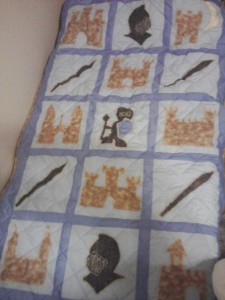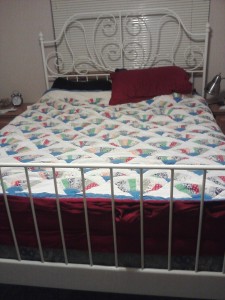Afghan 1 for Small Fry
I’ve always been afraid of crochet; my first two experiences with it weren’t exactly positive. The first was when I was pregnant with my oldest son. My late mother-in-law taught me a basic stitch so that I could make a baby blanket. The project took me most of the pregnancy, so I didn’t keep up with it – I’m an “instant gratification” kind of girl. When I got pregnant with my second son, I had an urge to make a similar blanket for him, so I did – my second major project. That one didn’t go any quicker than the first, so I dropped the hobby yet again.
When I stopped writing around December 2011/January 2012, my husband noticed that I seemed “aimless,” so he suggested I learn to knit. In his opinion, it would be a good hobby that I could do nearly anywhere. I thought, “What the heck,” and picked up some yarn and knitting needles from our local Jo-Ann store. Well, it turns out that knitting was even harder than crocheting! I tried for hours with YouTube videos and couldn’t get anything to stay on the needles, so the next day I went back to Jo-Ann and bought a set of crochet hooks instead – even if it was slow, at least I already knew how to do it. I had two skeins of yarn to use up, after all. My “first” project was a purse (essentially a piece of crochet “fabric” about 12×19 folded in half and sewn up the sides to make a pocket with a 3×36 strap). I was able to finish the entire thing (including a zippered liner sewn into the crocheted shell) in about 3 days. Talk about encouraging! I’d never been able to crochet that fast before. That took one full skein of yarn, but I still had one more. I headed back to YouTube to find a pattern I liked for a baby blanket. This was the one I came up with. We found out we were having another boy shortly before I finished this, so I added a royal blue border when I was done, and voilà! A baby blanket that didn’t take the entire pregnancy to complete!
Here’s the video I used for making this one:
[youtube=http://www.youtube.com/watch?v=mBWx_QXfX_M&list=PL608EA64FF1FB88F7&index=2&feature=plpp_video]





